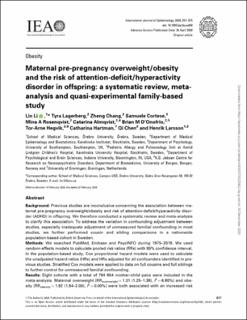| dc.contributor.author | Li, Lin | |
| dc.contributor.author | Lagerberg, Tyra | |
| dc.contributor.author | Chang, Zheng | |
| dc.contributor.author | Cortese, Samuele | |
| dc.contributor.author | Rosenqvist, Mina A. | |
| dc.contributor.author | Almqvist, Catarina | |
| dc.contributor.author | D'Onofrio, Brian M. | |
| dc.contributor.author | Hegvik, Tor-Arne | |
| dc.contributor.author | Hartman, Catharina A. | |
| dc.contributor.author | Chen, Qi | |
| dc.contributor.author | Larsson, Henrik | |
| dc.date.accessioned | 2021-05-18T11:21:07Z | |
| dc.date.available | 2021-05-18T11:21:07Z | |
| dc.date.created | 2020-11-17T13:03:51Z | |
| dc.date.issued | 2020 | |
| dc.Published | International Journal of Epidemiology. 2020, 49 (3), 857-875. | |
| dc.identifier.issn | 0300-5771 | |
| dc.identifier.uri | https://hdl.handle.net/11250/2755447 | |
| dc.description.abstract | Previous studies are inconclusive concerning the association between maternal pre-pregnancy overweight/obesity and risk of attention-deficit/hyperactivity disorder (ADHD) in offspring. We therefore conducted a systematic review and meta-analysis to clarify this association. To address the variation in confounding adjustment between studies, especially inadequate adjustment of unmeasured familial confounding in most studies, we further performed cousin and sibling comparisons in a nationwide population-based cohort in Sweden.
Methods
We searched PubMed, Embase and PsycINFO during 1975–2018. We used random-effects models to calculate pooled risk ratios (RRs) with 95% confidence interval. In the population-based study, Cox proportional hazard models were used to calculate the unadjusted hazard ratios (HRs) and HRs adjusted for all confounders identified in previous studies. Stratified Cox models were applied to data on full cousins and full siblings to further control for unmeasured familial confounding.
Results
Eight cohorts with a total of 784 804 mother–child pairs were included in the meta-analysis. Maternal overweight [RRoverweight = 1.31 (1.25–1.38), I2 = 6.80%] and obesity [RRobesity = 1.92 (1.84–2.00), I2 = 0.00%] were both associated with an increased risk of ADHD in offspring. In the population-based cohort of 971 501 individuals born between 1992 and 2004, unadjusted Cox models revealed similar associations [HRoverweight = 1.30 (1.28–1.34), HRobesity = 1.92 (1.87–1.98)]. These associations gradually attenuated towards the null when adjusted for measured confounders [HRoverweight = 1.21 (1.19–1.25), HRobesity = 1.60 (1.55–1.65)], unmeasured factors shared by cousins [HRoverweight = 1.10 (0.98–1.23), HRobesity = 1.44 (1.22–1.70)] and unmeasured factors shared by siblings [HRoverweight = 1.01 (0.92–1.11), HRobesity = 1.10 (0.94–1.27)].
Conclusion
Pre-pregnancy overweight/obesity is associated with an increased risk of ADHD in offspring. The observed association is largely due to unmeasured familial confounding. | en_US |
| dc.language.iso | eng | en_US |
| dc.publisher | Oxford University Press | en_US |
| dc.rights | Navngivelse 4.0 Internasjonal | * |
| dc.rights.uri | http://creativecommons.org/licenses/by/4.0/deed.no | * |
| dc.title | Maternal pre-pregnancy overweight/obesityand the risk of attention-deficit/hyperactivitydisorder in offspring: a systematic review, meta-analysis and quasi-experimental family-based study | en_US |
| dc.type | Journal article | en_US |
| dc.type | Peer reviewed | en_US |
| dc.description.version | publishedVersion | en_US |
| dc.rights.holder | Copyright The Author(s) 2020. | en_US |
| cristin.ispublished | true | |
| cristin.fulltext | original | |
| cristin.qualitycode | 2 | |
| dc.identifier.doi | 10.1093/ije/dyaa040 | |
| dc.identifier.cristin | 1848768 | |
| dc.source.journal | International Journal of Epidemiology | en_US |
| dc.source.40 | 49 | |
| dc.source.14 | 3 | |
| dc.source.pagenumber | 857-875 | en_US |
| dc.identifier.citation | International Journal of Epidemiology. 2020, 49 (3), 857-875. | en_US |
| dc.source.volume | 49 | en_US |
| dc.source.issue | 3 | en_US |

